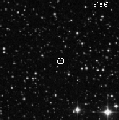V1974 Cygni
V1974 Cygni = Nova Cygni 1992
Coordinates: 2000.0 R.A.= 20:30:31.58 Dec.= +52:37:53.4
|
 |
V1974 Cygni, disovered by Collins (1992) on February 19,
1992, was the brightest nova since the outburst of Nova V1500 Cygni in
1975. Its V magnitude at maximum light was 4.4 and its outburst
amplitude was as large as 15 mag. With its t2,V=16 days it
was classified as a fast nova.
V1974 Cygni was observed in Ostrowik in years 1992-1997. The results of this
campaign were described in four papers published in Acta Astronomica.
|
CCD Photometry of Nova V1974 Cygni.
Acta Astronomica , 1994, Vol. 44, pp. 277-289
I. Semeniuk, W. Pych, A. Olech and M. Ruszkowski
Warsaw University Observatory, Al. Ujazdowskie 4, Warszawa, 00-478, Poland
September 12, 1994
Abstract:
We report a CCD optical photometry of Nova V1974 Cygni.
The period of the short-term modulation is equal to 0.0850 days
(122.4 min), different from 0.08123 days (117 min) reported by DeYoung
and Schmidt (1993). The period seems to be changing but the present
observations do not allow to reach any definite conclusion about the
sign of its derivative. A longer-term modulation is also visible in
the July 1994 observations of V1974 Cygni. If it is periodic then the
most probable approximate value of its period favoured by our data
is 3.75 days but 5.31 day period is also possible.
PDF version of this paper is
available.
Two Short-Term Periodicities of Nova V1974 Cygni
Acta Astronomica , 1995, Vol. 45, pp. 365-384
I. Semeniuk1, J.A. DeYoung2, W. Pych1,
A. Olech1, M. Ruszkowski1 and R.E. Schmidt
2
1Warsaw University Observatory, Al. Ujazdowskie 4,
Warszawa, 00-478, Poland
2US Naval Observatory Time Service Department,
3450 Massachusetts Avenue, NW, Washington, DC 20392-5420, USA
May 5, 1995
Abstract:
We report on analysis of V and I CCD photometry of Nova V1974 Cygni from
the observational seasons 1993 and 1994. The analysis gives evidence
that only one short-term modulation with period 0.0813 days was
obviously present in the 1993 I light curve of the nova. On the other
hand the analysis shows that two short-term modulations with periods
0.0813 and 0.085 days (whose values are close to 2-day aliases of one
another) are present in the 1994 V and I light curves of Nova V1974
Cygni. The 0.0813-day period is stable and we interpret it as the
orbital peiord of the system, while the 0.085-day period is decreasing
and may be the spin period of the white dwarf component of the system.
PDF version of this paper is
available.
CCD Photometry of Nova V1974 Cygni in 1995
Acta Astronomica , 1996, Vol. 46, pp. 311-323
A. Olech1, I. Semeniuk1, T. Kwast1,
W. Pych1, J.A. DeYoung2, R.E. Schmidt
2 and M. Nalezyty1
1Warsaw University Observatory, Al. Ujazdowskie 4,
Warszawa, 00-478, Poland
2US Naval Observatory Time Service Department,
3450 Massachusetts Avenue, NW, Washington, DC 20392-5420, USA
August 16, 1996
Abstract:
We report on analysis of I CCD photometry of Nova V1974 Cygni from the
observational season 1995. The analysis shows that both short-term
modulations with periods 0.0813 and 0.085 days (whose values are close
to 2-day aliases of one another) are still present in the light curve of
Nova V1974 Cygni. Contrary to the 1994 situation the amplitude of the
0.085-day modulation in 1995, was, on the average, smaller than the
amplitude of the 0.0813-day modulation. The observations give evidence
that the 0.0813-day period, interpreted as the orbital period of the
system, decreased during the time interval 1993--1995. The 0.085-day
period, observed as decreasing in 1994, stopped decreasing and seems to
increase since the middle of 1995. The light curve of V1974 Cygni
observed during some nights at the end of the 1995 season resembles the
light curve of a polar with two sets of minima.
PDF version of this paper is
available.
Nova V1974 Cyg - Results of the 1997 Campaign
Acta Astronomica , 2002, Vol. 52, pp. 273-291
Arkadiusz Olech
Nicolaus Copernicus Astronomical Center
Polish Acedemy of Science
ul. Bartycka 18, 00-716 Warszawa
August 7, 2002
Abstract:
This report analyzes the I-band CCD photometry of Nova V1974 Cyg from
the 1997 observational season. The analysis shows that both short-term
modulations with periods of 0.0813 and 0.085 days are still present in
the light curve of the star. We confirmed the stability of the shorter
period which is interpreted as the orbital period of the binary system.
Its value, determined using the O-C residuals, is
Porb=0.08125873(23) days = 117.0126(3) min. The longer period,
which appeared in the light curve in 1994, was decreasing until the
beginning of 1995 but then started to increase quite rapidly. In October
1996 the value of the period was 122.67+/-0.02 min. Until the next
observing run the period significantly decreased. Its value, as
determined from our observations performed in July 1997, was
121.87+/-0.12 min. This means that the rate of change of the period in
1996-1997 was as high as dP/dt = 10-6. Such a rapid change of the
period requires a large amount of rotational kinetic energy, if we
assume that a 122-min periodicity is the rotation period of a white
dwarf. Thus the more probable explanation is the hypothesis that the
longer period including a superhump period is caused by the precession
of an accretion disc surrounding a white dwarf primary.
PS version of this paper is
available.
